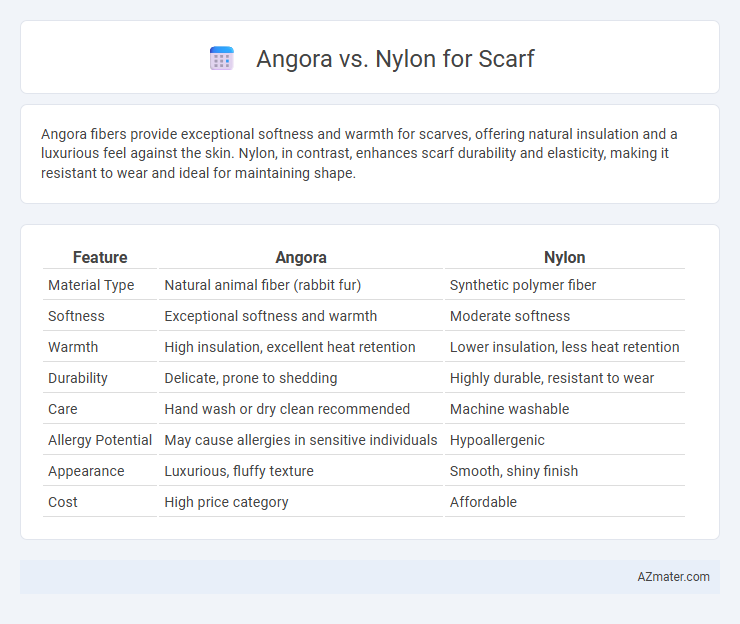Angora fibers provide exceptional softness and warmth for scarves, offering natural insulation and a luxurious feel against the skin. Nylon, in contrast, enhances scarf durability and elasticity, making it resistant to wear and ideal for maintaining shape.
Table of Comparison
| Feature | Angora | Nylon |
|---|---|---|
| Material Type | Natural animal fiber (rabbit fur) | Synthetic polymer fiber |
| Softness | Exceptional softness and warmth | Moderate softness |
| Warmth | High insulation, excellent heat retention | Lower insulation, less heat retention |
| Durability | Delicate, prone to shedding | Highly durable, resistant to wear |
| Care | Hand wash or dry clean recommended | Machine washable |
| Allergy Potential | May cause allergies in sensitive individuals | Hypoallergenic |
| Appearance | Luxurious, fluffy texture | Smooth, shiny finish |
| Cost | High price category | Affordable |
Introduction to Angora and Nylon Scarves
Angora scarves, crafted from the soft fibers of Angora rabbits, boast exceptional warmth and a luxurious texture that offers unparalleled comfort during cold weather. Nylon scarves, made from synthetic polymers, provide durable, lightweight, and moisture-resistant properties, making them versatile for various outdoor conditions. Choosing between Angora and Nylon scarves depends on preference for natural softness and insulation versus practical durability and ease of maintenance.
Origins and Production of Angora and Nylon
Angora originates from the Angora rabbit, primarily raised in regions like Turkey, where fine, soft fibers are hand-combed to produce luxurious yarn. Nylon, a synthetic polymer developed in the 1930s by DuPont, is created through a chemical process called polymerization, involving petroleum-based raw materials. The natural harvesting of Angora contrasts with the industrial, scalable production methods used for nylon, influencing their texture and environmental impact in scarf manufacturing.
Texture and Softness Comparison
Angora scarves offer exceptional softness due to the fine, silky fibers from Angora rabbits, creating a plush, luxurious texture that feels gentle against the skin. Nylon scarves, on the other hand, have a smoother, synthetic texture that can lack the natural softness and warmth found in Angora. Angora's breathable and insulating properties make it ideal for comfort, while nylon is more durable and lightweight but often less soft.
Warmth and Insulation Properties
Angora fibers provide superior warmth and insulation for scarves due to their hollow core structure, which traps heat effectively and offers a high warmth-to-weight ratio. Nylon, a synthetic fiber, lacks natural insulating properties but adds durability and moisture resistance when blended with other materials. Choosing angora for scarves maximizes thermal comfort in cold weather, while nylon enhances the fabric's strength and resilience.
Durability and Longevity
Angora fibers exhibit exceptional softness but tend to be less durable and prone to pilling and shedding over time compared to nylon. Nylon, a synthetic fiber, offers superior strength, resistance to abrasion, and retains its shape longer, making it ideal for scarves requiring longevity and everyday wear. Combining Angora with nylon blends can enhance durability while maintaining warmth and softness.
Moisture-Wicking and Breathability
Angora fibers offer excellent moisture-wicking properties by absorbing and releasing moisture quickly, making them ideal for regulating temperature and keeping the skin dry. Nylon, while durable and lightweight, tends to retain moisture and offers less breathability, which can lead to discomfort during extended wear. For scarves, angora provides superior breathability and natural moisture management compared to nylon, enhancing overall comfort in varying climates.
Allergy Considerations
Angora wool, derived from Angora rabbits, is prized for its softness but can trigger allergic reactions due to its protein-based fibers, causing itching or respiratory issues in sensitive individuals. Nylon, a synthetic fiber, is hypoallergenic and less likely to cause skin irritation or allergies, making it a suitable choice for those with sensitive skin or wool allergies. Choosing nylon scarves reduces the risk of allergic reactions, while Angora scarves require caution for allergy-prone users.
Maintenance and Care Tips
Angora scarves require delicate hand washing with mild detergent and air drying to preserve their softness and prevent fiber damage, while nylon scarves are more durable and machine washable on gentle cycles, making them easier to maintain. Angora fibers are prone to matting and shedding, so storing these scarves in breathable garment bags and avoiding friction is essential for longevity. Nylon scarves benefit from quick drying and wrinkle resistance but should be kept away from high heat during ironing to prevent melting or deformation.
Price and Value Differences
Angora scarves typically cost more than nylon due to the natural softness, warmth, and rarity of angora fibers, offering superior insulation and luxury feel. Nylon scarves are more affordable and durable, providing lightweight and easy-care options but lacking the warmth and premium texture of angora. The price difference reflects the value in comfort and exclusivity, with angora scarves being a higher-end investment compared to versatile, budget-friendly nylon alternatives.
Best Choice: Angora or Nylon for Scarves?
Angora scarves provide exceptional warmth, softness, and natural breathability, making them ideal for cold-weather use and sensitive skin. Nylon scarves offer durability, moisture resistance, and easy maintenance, but lack the luxurious softness and insulation of angora. For a blend of comfort and longevity, angora is the best choice for scarf enthusiasts seeking premium warmth and texture.

Infographic: Angora vs Nylon for Scarf
 azmater.com
azmater.com